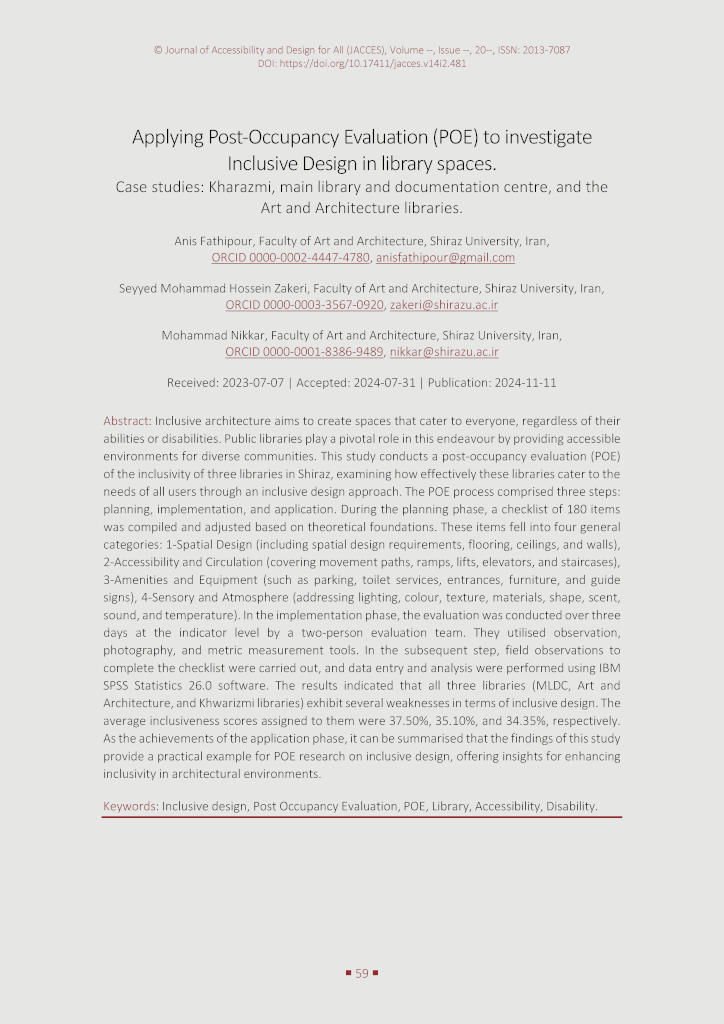Applying Post-Occupancy Evaluation (POE) to Investigate Inclusive Design in Library Spaces.
DOI:
https://doi.org/10.17411/jacces.v14i2.481Abstract
Inclusive architecture aims to create spaces that cater to everyone, regardless of their abilities or disabilities. Public libraries play a pivotal role in this endeavour by providing accessible environments for diverse communities. This study conducts a post-occupancy evaluation (POE) of the inclusivity of three libraries in Shiraz, examining how effectively these libraries cater to the needs of all users through an inclusive design approach. The POE process comprised three steps: planning, implementation, and application. During the planning phase, a checklist of 180 items was compiled and adjusted based on theoretical foundations. These items fell into four general categories: 1-Spatial Design (including spatial design requirements, flooring, ceilings, and walls), 2-Accessibility and Circulation (covering movement paths, ramps, lifts, elevators, and staircases), 3-Amenities and Equipment (such as parking, toilet services, entrances, furniture, and guide signs), 4-Sensory and Atmosphere (addressing lighting, colour, texture, materials, shape, scent, sound, and temperature). In the implementation phase, the evaluation was conducted over three days at the indicator level by a two-person evaluation team. They utilised observation, photography, and metric measurement tools. In the subsequent step, field observations to complete the checklist were carried out, and data entry and analysis were performed using IBM SPSS Statistics 26.0 software. The results indicated that all three libraries (MLDC, Art and Architecture, and Khwarizmi libraries) exhibit several weaknesses in terms of inclusive design. The average inclusiveness scores assigned to them were 37.50%, 35.10%, and 34.35%, respectively. As the achievements of the application phase, it can be summarised that the findings of this study provide a practical example for POE research on inclusive design, offering insights for enhancing inclusivity in architectural environments.References
Aslefallah, M., & Hashemi, N.-S. (2019). A Study on People with Disabilities Needs and Problems in Tehran Urban Parks with Design Perspective. Journal of Fine Arts: Visual Arts, 24(2), 123-130, https://doi.org/10.22059/JFAVA.2018.242935.665754
BHRC. (2020). Urban and Architectural Design Criteria for People with Disability. Tehran, Iran: Road, Housing and Urban Development Research Center. https://en.civilica.com/doc/1225075/
Elsayed, M., Pelsmakers, S., Pistore, L., Castaño-Rosa, R., & Romagnoni, P. (2023). Post-occupancy evaluation in residential buildings: A systematic literature review of current practices in the EU. Building and Environment, 236, https://doi.org/10.1016/j.buildenv.2023.110307
HEFCE. (01 de 04 de 2006). ICDST pdf E-prints repository. Recuperado el 18 de 06 de 2023, de The International Center for Development of Science and Technology (ICDST) Research: https://dl.icdst.org/pdfs/files/d6b003aaaa2d9973aa60a91faa64e0d4.pdf
Heylighen, A., Van der Linden, V., & Van Steenwinkel, I. (2017). Ten Questions Concerning Inclusive Design of the Built Environment. Building and Environment, 114, 507-517. https://doi.org/10.1016/j.buildenv.2016.12.008
Karami, A., & Ardalan, H. (2015). Investigating Order as an Aesthetic Criterion in Architecture. National Conference on Native Architecture and Urbanism of Iran. Yazd. https://civilica.com/doc/544759/
Karbalaei Hosseini Ghiyasvand, A., Sattari, M., Soltanzadeh, H., & Farahbod, M. (2018). Presenting an Analytical Model for Recognizing and Evaluating the Environmental Indicators Influencing the Increase in social interactions of children with autism in Educational Centers Using Analytic Hierarchy Process. Armanshahr, 12(28), 75-89. https://www.sid.ir/paper/202285/en
Li, P., Froese, T. M., & Brager, G. (2018). Post-occupancy evaluation: State-of-the-art analysis and state-of-the-practice review. Building and Environment, 133, 187-202, https://doi.org/10.1016/j.buildenv.2018.02.024
Noroziyan Maleki, S., & Hosseini, S. (2008). Enabling of Housing and Urban Environments for People with Mobility Limitations (Case Study: 8th Region of Tehran). International Journal of Industrial Engineering and Production Management (IJIE), 19(10-2), 197-206. https://www.sid.ir/paper/358872/en
Preiser, W. F. (2001). The Evolution of Post-Occupancy Evaluation: Toward Building Performance and Universal Design Evaluation. En N. A. Press, Learning from Our Buildings: A State-of-the-Practice Summary of Post-Occupancy Evaluation (págs. 1-22). Washington, DC: National Academy Press. https://doi.org/10.17226/10288
Preiser, W. F., White, E., & Rabinowitz, H. (2015). Post-Occupancy Evaluation (Routledge Revivals) (1st Edition ed.). London: Routledge. https://doi.org/10.4324/9781315713519
Shabani, A., & Salavatian, S. (2021). Development of inclusive housing: toward a multisensory design approach. Journal of Architectural Thought,, 5(10), 218-236. https://doi.org/10.30479/AT.2021.13232.1516
WHO. (2011). Summary: World Report on Disability 2011. World Health Organization (WHO). https://www.who.int/publications/i/item/WHO-NMH-VIP-11.01

Downloads
Published
How to Cite
Issue
Section
License
Copyright (c) 2024 Anis Fathipour, Seyyed Mohammad Hossein Zakeri, Mohammad Nikkar

This work is licensed under a Creative Commons Attribution-NonCommercial 4.0 International License.
- Authors retain copyright and grant the journal right of first publication with the work simultaneously licensed under a Creative Commons Attribution License that allows others to share or adapt the work with an acknowledgment of the work's authorship and initial publication in this journal. Use of the work for commercial purposes are not allowed.
- Authors are able to publish the journal's published version of the work in other media (e.g., post it to an institutional repository or publish it in a book), as far as they inform the Journal of Accessibility and Design for All of that fact. When publishing their work in other sources, authors must mention the name of the Journal of Accessibility and Design for All, its ISSN, the number and issue in which the article was published and a link to the main page of the Journal of Accessibility and Design for All. Optionally, they can also include a link to the article published in the Journal of Accessibility and Design for All.
- Authors are permitted and encouraged to post their work online (e.g., in institutional repositories or on their website), as it can lead to productive exchanges, as well as earlier and greater citation of published work.

